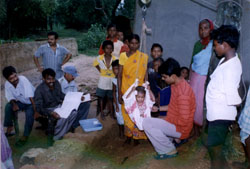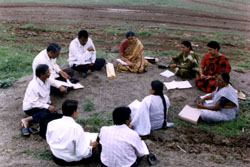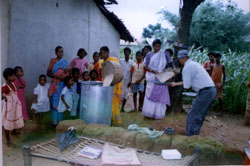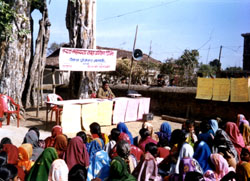|
A Model Development
Plan for Bundelkhand Ashok Gopal info@infochange.com The Bundelkhand region of Uttar Pradesh and Madhya Pradesh, which is one of the most backward parts of the country, is the focus of a unique and large-scale development initiative launched recently. For the first time, several national, regional and local Civil Society Organisations
(CSOs) will be working together within time-bound frameworks to bring about a fundamental transformation in this area. The initiative has been launched under the seven-year Poorest Areas Civil Society (PACS) Programme sponsored by the UK government’s Department for International Development (DFID) In Bundelkhand, where nine of the 108 poorest districts in India are located, an outreach workshop for integrated development for the region was organised to bring various CSOs under one platform. The workshop was held on June 27th and 28th, 2003 at Development Alternatives’ Appropriate Technology Demonstration Village – TARAgram near Orchha in Madhya Pradesh. The accent of the workshop was on arriving at a common understanding of the problems of the region and the most relevant development options. Representatives of over 50 CSOs that work in the region, or have a desire to do so, attended this intensive brain-storming event conducted by senior DA personnel. As George Varughese, Vice-President of DA stressed: "It is important to have a "shared vision and broad strategies" and to "forge partnerships for action".
Several ideas for effective strategies suited to the physical, social and economic conditions of the region emerged during the workshop. The house in general was of the opinion that there existed many opportunities for increasing livelihood options, without bringing in capital-intensive industry. Participants at the workshop agreed on the tremendous potential for development in the region, despite the high levels of poverty, poor state of infrastructure and continuing environmental degradation. They identified the following key drivers for the development of Bundelkhand within the PACS framework:
Participating CSOs will now form groups among themselves and submit concept notes for common action programmes that meet some or all the above-mentioned objectives. The concept notes are expected to be submitted by August 15, 2003. In each group, one CSO is expected to act as the lead agency, which would be responsible for managing the programme and accounting for the DFID funding that will be disbursed by the Consortium. q
|
||||||||||||||||||||||||||||||||||||



